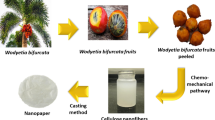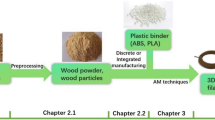Abstract
Falcataria moluccana or sengon is one of the fast-growing wood species widely grown in Indonesia. However, its wood is low quality with low density, and poor strength, durability, and dimensional stability. This study determined the effects of impregnation with monoethylene glycol (MEG) and nano-SiO2 on the characteristics of sengon wood, including its dimensional stability and density. Impregnation with MEG and nano-SiO2 had a significant effects on dimensional stability in terms of the weight percent gain, anti-swelling efficiency, water uptake, bulking effect, and density. The impregnated wood was examined by scanning electron microscopy coupled with energy-dispersive X-ray spectroscopy and X-ray diffraction. The results show that MEG and nano-SiO2 were distributed homogeneously into cell walls of wood treated with 0.5% MEGSiO2.



Similar content being viewed by others
References
ATSDR [Agency for Toxic Substances and Disease] (1997) Agency Toxicological Profile for Ethylene Glycol and Propylene Glycol, p 249. Atlanta USA: Department of Health and Human Services, Public Health Service
Bowyer JL, Shmulsky R, Haygreen JG (2007) Forest product and wood science: an introduction, 5th edn. Blackwell Publishing Professional, Iowa
BPS [Badan Pusat Statistik] (2016) Statistik produksi kehutanan 2015 (Statistics of forest product 2015). Badan Pusat Statistik, Jakarta
BS [British Standard] (1957) Methods of testing small clear specimens of timber. BS 373:1957
Cave I (1997) Theory of X-ray measurement of microfibril angle in wood. Wood Sci Technol 31:225–234
Clausen CA, Yang VW, Arang RA, Green F (2009) Feasibility of nanozinc oxide as a wood preservative. Am Wood Prot Assoc Proc 105:225–260
Clausen CA, Green F, Kartal SN (2010) Weatherability and leaching resistance of wood impregnated with nano-zinc oxide. Nanoscale Res Lett 14:64–67
Darma IGKT, Hadi YS, Atmojo AT (2002) Ketahanan komposit kayu plastik polistirena terhadap serangan jamur pelapuk coklat (Tyromyces palustris) (Durability of polystyrene wood plastic composite against brown rot attack). J Trop For Manag 8:31–38 (article in Indonesian with an abstract in English)
Darusman D, Hardjanto (2006) Kontribusi hutan rakyat dalam kesinambungan industri kehutanan (Contribution of community forest on sustainable forestry industries). Prosiding Seminar Hasil Litbang Hasil Hutan, Bogor (in Indonesian)
Dong Y, Yan Y, Zhang S, Li J (2014) Wood/polymer nanocomposites prepared by impregnation with furfuryl alcohol and nano SiO2. BioResources 9:6028–6040
Dong Y, Yan Y, Zhang S, Li J, Wang J (2015) Flammability and physical–mechanical properties assessment of wood treated with furfuryl alcohol and nano-SiO2. J Wood Prod 73:457–464. https://doi.org/10.1007/s00107-015-0896-y
Eisenreich SJ, Looney BB, Thornton JD (1981) Air borne organic contaminants in the Great Lakes ecosystem. Environ Sci Technol 15:30–38
Freeman MH, McIntyre CR (2008) Comprehensive review of copper-based wood preservative. For Prod J 58:21–27
Fufa SM, Hovde PJ (2010) Nano-based modifications of wood and their environmental impact: review. In: World conference on timber engineering, June 20th–24th, 2010. Riva del Garda, Italy
Guigo N, Mija A, Zavaglia R, Vincent L, Shirrazzouli N (2009) New insight on the thermal degadation pathways of neat poly (furfuryl alcohol) and poly (furfuryl alcohol) SiO2 hybrd materials. Polym Degrad Stab 94:908–913
Hadi YS, Rahayu IS, Danu S (2013) Physical and mechanical properties of methyl metacrylate impregnated jabon wood. J Indian Acad Wood Sci. https://doi.org/10.1007/s13196-013-0098-3
Hadi YS, Rahayu IS, Danu S (2015) Termite resistance of jabon wood impregnated with methyl metaacrylathe. J Trop For Sci 27:25–29
Hadiyawarman Rijal A, Nuryadin B, Abdullah M, Khairurijal K (2008) Fabrikasi material nanokomposit superkuat, ringan dan transparan menggunakan metode simple mixing (Fabrication of superstrength, light and transparent nanocomposite material by simple mixing method). J Nanosains dan Nanoteknologi 1:14–21 (article in Indonesian with an abstract in English)
Hill CAS (2006) Wood modification: chemical, thermal and other processes. Wiley, Chichester
Hill CA, Norton AJ, Newman G (2010) The water vapour sorption properties of Sitka spruce determined using a dynamic vapour sorption apparatus. Wood Sci Technol 44:497–514
Hill CAS (2011) Wood modification: an update. BioResources 6:918–919
Jasni Hadjib N, Barly Hadi YS, Afidudin Y (2004) The resistence of wood polymer composite to the dry wood rermite (Cryptotermes cycocephalus Light) and the subterranean termite (Coptotermes curvignathus Holmgreen) infestation. J For Res 1:50–59
Koksal F, Altun F, Yigit I, Shin Y (2008) Combined effect of silica fume and steel fiber on the mechanical properties of high strength concretes. Constr Build Mater 22:1874–1880
Krisnawati H, Varis E, Kallio M, Kanninen M (2011) Paraserianthes falcataria L. Nielsen ecology, silviculture and productivity. CIFOR, Bogor
Leng Y (2002) Materials Characterization introduction to microscopic and spectroscopic method. Wiley, New York
Mai C, Weigenand O, Ghosh S, Miliyz H (2007) Effects of wood treatment with amino-silicone emulsion on different material properties. In: European conference on wood modification, 15–16 October 2007, United Kingdom
Martawijaya A, Kartasujana I, Kadir K, Prawira SA (2005) Indonesian wood atlas I. Forest Product Research, Bogor
Meints T, Hansmann C, Gindl-Altmutter W (2018) Suitability of different variants of polyethylene glycol impregnation for dimensional stabilization of oak wood. Polymers 10:81. https://doi.org/10.3390/polym10010081
Merz R, Cooper G (1968) Effect of polyethylene glycol on stabilization of black oak blocks. For Prod J 18:55–59
Ministry of Environment and Forestry (2014) [Direktorat BPPHH Ditjen BUK] Forestry Statistics of Indonesia. 2013. Jakarta (ID): Ministry of Environment and Forestry, Jakarta, Indonesia
Mitchell HL (1972) How PEG helps the hobbyist who works with wood. US. Department of Agriculture, Forest Service. Forest Product Laboratory, 20 p
Orwa C, Mutua A, Kindt R, Jamnadass R, Anthony S (2009) Agroforestry tree database: a tree references and selection guide version 4.0. www.worldagroforestry.org/treeb2/AFTPDFS/Paraserainthes_falcataria.pdf Accessed 10 Feb 2018
Pries M, Wagner R, Kaesler KH, Militz H, Mai C (2013) Effect of short-chain silicones bearing different functional groups on the resistance pine (Pinus sylvestris L.) and beech (Fagus sylvatica L.) against decay fungi. Holzforschung 67:447–454
Rahayu I, Darmawan W, Nugroho N, Nandika D, Marchal R (2014) Demarcation point between juvenile and mature wood Sengon (Falcataria moluccana) and Jabon (Anthocephalus cadamba). J Trop For Sci 26:331–339
Ralph J (2006) Chemical treatment of backsawn Tasmanian oak (Dissertation). School of Human Life Science, University of Tasmania, Launceston
Rowell RM (1980) Distribution of reacted chemicals in southern pine modified with methyl isocyanate. Wood Sci 13:102–110
Rowell RM, Ellis WD (1978) Determination of dimensional stabilization of wood by water soak method. Wood Fiber Sci 10:104–111
Rowell RM, Writer PK (1987) Treatments that enhance physical properties of wood, 12p. US. Department of Agriculture, Forest Service. Forest Product Laboratory
Shi J, Li J, Zhow W, Zhang D (2007) Improvement of wood properties by urea formaldehyde and nano-SiO2. Front For China 2:104–109
Soerianegara I, Lemmens RHMJ (1993) Plant resources of South-East Asia 5(1): timber trees: major commercial timber. Pudoc Scientific Publishers, Wageningen
Stamm AJ (1959) Effect of polyethylene glycol on the dimensional stability of wood. For Prod J 9:375–381
Trung T, Cho WJ, Ha CS (2003) Preparation of TiO2 nanoparticles in glycerol containing solution. Mater Lett 57:2746–2750
Tsoumis G (1991) Wood as raw material: source, structure, chemical, composition, growth, degradation and identification. Pergamon Press, Oxford
Wardani L, Risnasari I, Yasni, Hadi YS (2012) Resistance of jabon timber modified with styrene and methyl metaacrylathe against dry wood termites and subterranean termites. In: Proceedings of 9th Pacific Rim Termite Research Group conference, pp 27–28. Hanoi, Vietnam
Xue F, Zhao G (2008) Optimum preparation technology for Chinese fir wood/Ca-montmorillonite (Ca-MMT) composite board. For Stud China 10:199–204
Zhang SY, Yu Q, Beaulieu J (2004) Genetic variation in veneer quality and its correlation to growth in white spruce. Can J For Res 34:1311–1318
Acknowledgements
The authors would like to thank the Directorate of Research and Innovations of Bogor Agricultural University.
Author information
Authors and Affiliations
Corresponding author
Additional information
Publisher's Note
Springer Nature remains neutral with regard to jurisdictional claims in published maps and institutional affiliations.
Project funding: This work was supported by the Ministry of Research, Technology and Higher Education (RISTEKDIKTI), Republic of Indonesia, under the Leading Research University Competitive Grant with contract No 079/SP2H/LT/DRPM/II/2016.
The online version is available at http://www.springerlink.com
Corresponding editor: Yu Lei.
Electronic supplementary material
Below is the link to the electronic supplementary material.
Rights and permissions
About this article
Cite this article
Rahayu, I., Darmawan, W., Zaini, L.H. et al. Characteristics of fast-growing wood impregnated with nanoparticles. J. For. Res. 31, 677–685 (2020). https://doi.org/10.1007/s11676-019-00902-3
Received:
Accepted:
Published:
Issue Date:
DOI: https://doi.org/10.1007/s11676-019-00902-3




